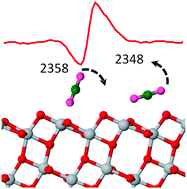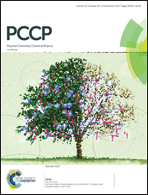CO2 adsorption on anatase TiO2(101) surfaces: a combination of UHV-FTIRS and first-principles studies†
Abstract
The CO2 adsorption and dynamic behaviors on single crystal anatase TiO2(101) surfaces were investigated by UHV-FTIRS and first-principles calculations. The IRRAS results at 90 K show that the ν3(OCO) asymmetric stretching vibration of adsorbed CO2 exhibits band splitting at rather low CO2 coverage in p-polarized IR spectra for the IR beam incident along the [10![[1 with combining macron]](https://www.rsc.org/images/entities/char_0031_0304.gif) ] direction. Co-adsorbed CO can prevent such band splitting. Ab initio molecular dynamics (AIMD) simulations revealed that the adsorbed CO2 at finite temperature does not keep a stationary adsorption state but keeps a certain swing motion: one end of the linear CO2 molecule binds to surface Ti5c sites and the other end swings within the (010) plane with a tilted angle distribution ranging from 10° to 60° relative to the [10
] direction. Co-adsorbed CO can prevent such band splitting. Ab initio molecular dynamics (AIMD) simulations revealed that the adsorbed CO2 at finite temperature does not keep a stationary adsorption state but keeps a certain swing motion: one end of the linear CO2 molecule binds to surface Ti5c sites and the other end swings within the (010) plane with a tilted angle distribution ranging from 10° to 60° relative to the [10![[1 with combining macron]](https://www.rsc.org/images/entities/char_0031_0304.gif) ] direction. By suggesting a statistical model, we confirmed that it is the swing motion that results in the band splitting phenomenon of CO2 vibration in IR spectra. The co-adsorbed CO decreases the swing angle distribution ranging from 10° to 45° through the intermolecular interaction between CO and CO2, leading to the disappearance of CO2 band splitting.
] direction. By suggesting a statistical model, we confirmed that it is the swing motion that results in the band splitting phenomenon of CO2 vibration in IR spectra. The co-adsorbed CO decreases the swing angle distribution ranging from 10° to 45° through the intermolecular interaction between CO and CO2, leading to the disappearance of CO2 band splitting.



 Please wait while we load your content...
Please wait while we load your content...